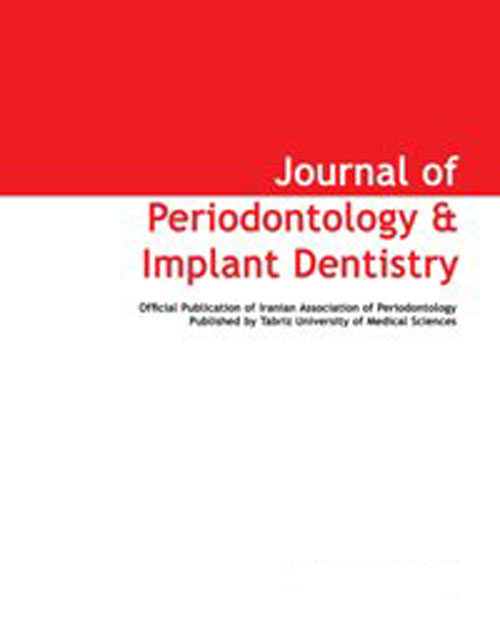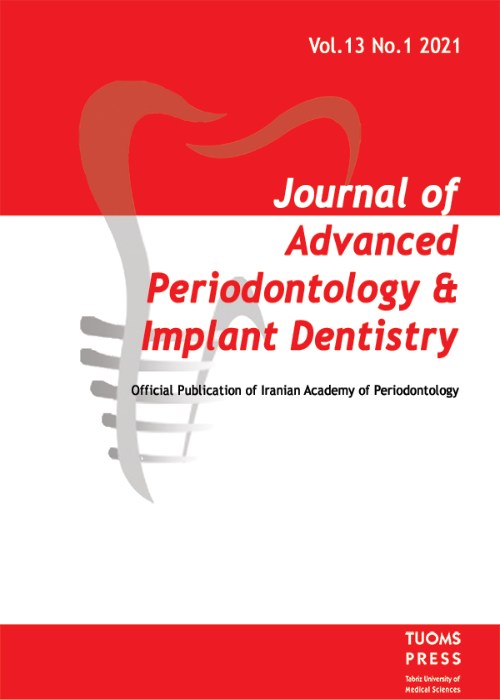فهرست مطالب

Journal of Advanced Periodontology and Implant Dentistry
Volume:7 Issue: 2, Dec 2015
- تاریخ انتشار: 1394/09/30
- تعداد عناوین: 7
-
-
Pages 35-38PurposesThe aim of this study was to evaluate the intra and inter-examiner reliability and reproducibility of linear measurements in cone-beam tomography (CBCT) images taken by calibrated radiologists and periodontists.Materials And MethodsThe alveolar ridge dimensions in selected CBCT images were measured by two calibrated radiologists and two periodontists. Intra and inter-examiner reliability was evaluated by intra-rater and intra-class correlation coefficients (ICCs).ResultsICCs between the intra-and inter-examiners obtained with the different methods showed almost perfect matches. The results demonstrated high examiner reproducibility for linear parameters of alveolar ridges in CBCT images in presurgical implant site assessment.ConclusionThe alveolar ridge dimensions provided by the radiologists might be useful for the periodontists. The measurement in small differences in is related to the experience and skills of the examiner, inclination measurement, selection of the exact level of the alveolar crest and the ability to detect the exact anatomic borders in CBCT images.Keywords: Cone, beam computed tomography, dental implants, linear measurements
-
Pages 39-43BackgroundThere is a hypothesis that people with rheumatoid arthritis (RA) can also be at risk of periodontal disease. This study aimed to assess the periodontal health in patients with and without rheumatoid arthritis. Methods and Materials: Thirty RA patients with RA and 30 healthy individuals without RA were included. Information regarding demographic characteristics and periodontal parameters (Probing pocket depth, Attachment Loss, plaque index, simplified oral hygiene index and modified gingival index) were recorded.ResultsThere was no significant difference in periodontal parameters among participants with and without RA.ConclusionsAccording to the cross-sectional pattern of the present study, more evaluation is needed to determine the possible role of RA on periodontal status of patients.Keywords: rheumatoid arthritis, periodontal health
-
Pages 44-49Background and aims. The aim of this study was to evalute the effect of double pedicle graft (DPG) with and without plasma rich in growth factor (PRGF) in the treatment of Miller's Cl I and II gingival recessions. Materials and methods. Thirty two bilateral buccal gingival Miller’s Cl I and II recessions were selected. sixteen of the recessions were treated with DPG and PRGF (test group). The remaining fifteen recessions were treated with DPG (control group). The clinical parame¬ters, including Clinical probing depth(CPD), clinical attach¬ment level (CAL), recession depth (RD),Recession width(RW), keratinized gingiva width(KGW), were measured at baseline and 1, 3 and 6 months later. Data were analyzed with paired T test. Results. After 6 months, both groups exhibited a significant improvement in all the criteria mentioned above. However, none of the groups showed significant differences in pocket depths after 6 months. At the end of the study there were significant improvements in recession depths and widths and clinical attach¬ment levels and keratinized gingiva width between test and control groups. Conclusion. The method using DPG+PRGF resulted in more favorable clinical outcomes than only DPG.Keywords: Recession, double papilla graft, PRGF
-
Pages 50-54Background And AimsPlasma rich in growth factors (PRGFs) has been recently proposed as an aid to enhance regeneration of osseous and epithelial tissues in oral surgery. The purpose of this study was to determine the effect of local application of Platelet Rich Plasma (PRP) on implant stability measured by periotest.Materials And MethodsA total of 24 implants were placed in mandible of 12 lower edentulous patients. In each patient, 2 implants were placed anterior to mental foramen in bilateral canine sites. One implant in each patient was dipped in autogenous PRP before insertion (test group), while the other implant was not embedded in PRP (control group). Repeated stability measurements were done by periotest on the day of surgery, 1, 2, 4 and 8 weeks after surgery.ResultsIn both groups minimum periotest values (highest stability) was observed in the day of surgery and 8 weeks after surgery. The maximum periotest values (lowest stability) were observed in 4th week after surgery. Considering implant stability, no statistically significant differences was observed between test and control groups at any time (P>0.05). In PRP group, the difference in implant stability between the day of surgery to 2nd and 4th weeks were statistically significant (pKeywords: Implant stability, osseointegration, periotest, platelet, rich plasma
-
Pages 55-60Background And AimsNowadays miniscrews are widely used as skeletal anchorage in orthodontics. However the success rate of miniscrews is less than that of osseointegrated implants. The aim of this retrospective study was to evaluate factors influencing the success rate of orthodontic miniscrews.Materials And MethodsData of 244 miniscrews in 122 patients (99 females and 23 males, with a mean age of 19 years and 6 months) were collected. Logistic regression analysis was used to evaluate the effect of age, gender, placement side and insertion torque on the success rates of miniscrews.ResultsThe overall success rate of miniscrews was 90.6% in the present study (221/244). Logistic regression analysis showed that the success rate of miniscrews was not under the influence of variables such as gender, placement side and miniscrew brand. However, age groups and insertion torques over 10 Ncm decreased miniscrew success rates. In this context, the success rates of miniscrews in patients under 16 years of age was less than those in patients over 16 years of age (P<0.001) and the success rates of miniscrews with insertion torques ≤10 Ncm were higher than those with insertion torques over 10 Ncm (P=0.019).Conclusion. We concluded that patients under 16 years of age and insertion torques over 10 were increased the failure of orthodontic miniscrews.Keywords: Age, Insertion torque, Miniscrew, Success rate
-
Pages 61-65Idiopathic or hereditary gingival fibromatosis (HGF) is a relatively rare disease characterized by the enlargement of the gingiva, resulting in functional, esthetics and psychological disturbances. The degree of gingival overgrowth can be defined as: grade 0: no sign of gingival enlargement; grade I: enlargement confined to interdental papilla; grade II: enlargement involves papilla and marginal gingiva; and grade III: enlargement covers three quarters or more of the crown. This case report describes the case of a 16-year-old girl suffering from HGF with chief complaint of gingival swelling. Intraoral examination exhibited diffuse and grade III gingival enlargement in both jaws and also in both surfaces of buccal and lingual/palatal. Treatment included surgery (internal and external gingivectomy) in six sessions, and prescription of antibiotics and 0.2% chlorhexidine mouthwash. Moreover, gingivoplasty was performed in the esthetic zone of maxilla after performing all the surgeries in the mouth. The patient was under regular follow-up visits. The treatment outcomes after six months were satisfactory and no symptoms of recurrence were observed.Keywords: Gingival fibromatosis, gingival enlargement, gingivectomy
-
Pages 66-69The palatogingival grooves are an anatomical anomaly in maxillary incisors and the presence of them may result in local periodontal pocket formation, bone loss and sometimes pulpal necrosis. In the present case, there was a groove on the palatal side of maxillary lateral incisor with vital pulp. The periodontal problem of the tooth was treated and the 6 month postoperative follow up showed attachment gain and decreased pocket depth.Keywords: Anatomical anomaly, bone graft, palate, gingival groove


